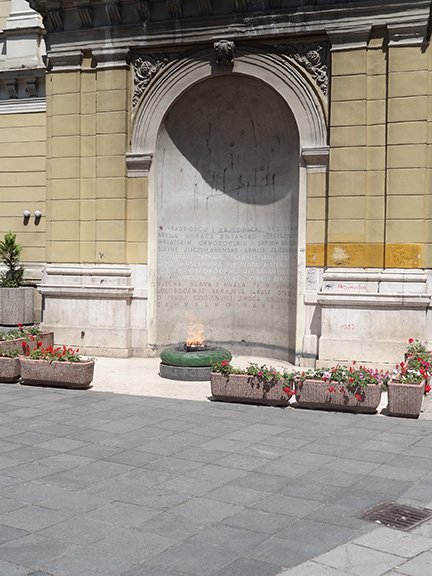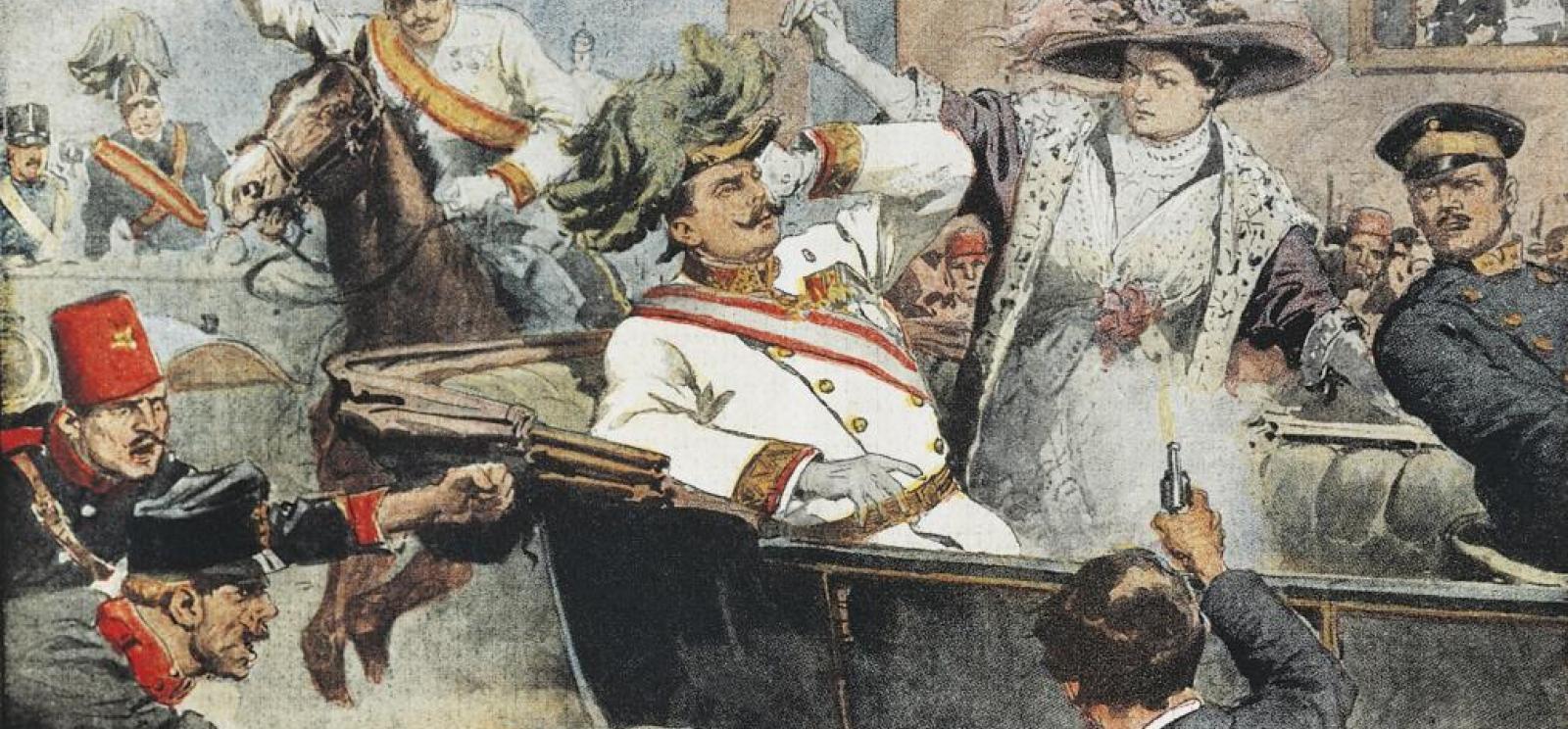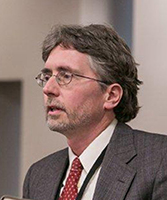
National World War I Museum Archivist Jonathan Casey travels to Sarajevo, Bosnia, and Vienna, Austria, between June 23-July 3, 2014. Join us each day during this remarkable journey as Jonathan reports from these two cities at the heart of the World War I conflict as the Centennial commences.
Trip Overview
Monday, June 16
I will be fortunate to witness the Centennial of the assassination of Archduke Franz Ferdinand and his wife, Sophie from the very city where this history changing event took place. My goal for this experience is to provide you with a glimpse into how people in Sarajevo and Vienna are commemorating the Centennial.
My trip begins in Vienna on June 23. I’ll spend a few days there before traveling to Sarajevo, where I’ll stay from June 26-July 1. I’ll then return to Vienna before going back to the U.S. on July 3.
I will be visiting with senior staff at the Austrian National Library for a tour of their institution and the initiating of a professional relationship between the ANL and the National World War I Museum.
I also plan on meeting with Notre Dame professor John Deak, who specializes in the history of the Austro-Hungarian Empire. Professor Deak presented a lecture about the assassination and the “July Crisis” of 1914 at the Museum in April and now he is doing research at various institutions in Vienna this summer.
After I return from Sarajevo, I will see an exhibit about the assassination at the Army History Museum that opens on the Centennial anniversary date: June 28. The exhibit includes the car that Franz Ferdinand and Sophie were riding in, the archduke’s blood-stained tunic and the pistol used by the assassin, a Bosnian Serb named Gavrilo Princip.
In Sarajevo, I will be tracing the route of the archduke’s motorcade on the fateful day I plan to be at “ground zero,” where Princip fired two shots at the archduke’s car, at the same time—approximately 11:00—on the morning of June 28. There are numerous public events planned in Sarajevo for the Centennial observance, including exhibits and concerts.
I plan on meeting University of Arizona professor and Balkans history expert Lisa Adeli, who was a National World War I Museum Teacher Fellow in the 2012 inaugural class. Professor Adeli has visited Sarajevo and other places in Bosnia several times and speaks the native tongue, so she will serve as a tremendous resource in exploring the city.
As an interesting twist to the trip, I will have the opportunity to meet with Helen Patton, the granddaughter of the famous WWII general George S. Patton. Ms. Patton is an artist, concert vocalist and actress. Her grandfather is best known for his service in WWII, but was a junior officer in WWI and instrumental in creating the U.S. Tank Corps. Helen and I will be staying at the same hotel in Sarajevo and I look forward to listening to many stories and insights from her.
This is just a snapshot of what I plan to see and do during this trip. I hope you’ll enjoy having this window into the events and attractions in Vienna and Sarajevo for the start of the World War I Centennial. Whatever happen I plan on having a “Whiz Bang” of a time!
The Journey Begins
Monday, June 23
“…It was the best of times, it was the worst of times...it was the season of Light, it was the season of Darkness, it was the spring of hope, it was the winter of despair…” excerpt from the opening to A Tale of Two Cities
This witness to history tour is, at its heart, a tale of two cities – Vienna and Sarajevo – two places with distinct personalities and characteristics that played opening roles in the WWI tragedy. Metaphorically, Vienna with its political/administrative/arts center of neo-classical, monumental buildings was in 1914 the “light” of civilization, a center of culture and majesty. In contrast, Sarajevo was a small, poor border province of a foreign power, perhaps Vienna's antithesis: the “darkness” of an alien people and culture, of conspirators meeting in secret, in the darkness, determined to change the existing order.
I arrived at the Vienna airport about 8:30 a.m., and began my “history tour” with a rush hour weaving in and out of traffic on my journey to the hotel, which is in an older part of town. Vienna dates back to Roman times, so old is a relevant adjective. The hotel was built in 1901 and has a central, open staircase, high ceilings and antique hardware doors from the time period.
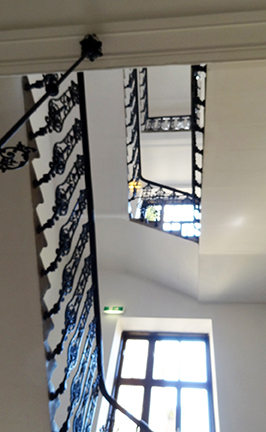
The hotel’s location is ideal for walking and sightseeing. There are lots of small shops – boutiques, restaurants – particularly in the area near the hotel, and a number of Asian eateries – Vietnamese, Indian, Japanese – but also Italian and a British pub. There are a large number of churches, one near the hotel, St. Ulrich, a smaller structure, sort of tucked away from the street, but with a clock tower showing its face above the rooftops. There are several churches in the downtown area of medieval or Baroque architecture with soaring spires.
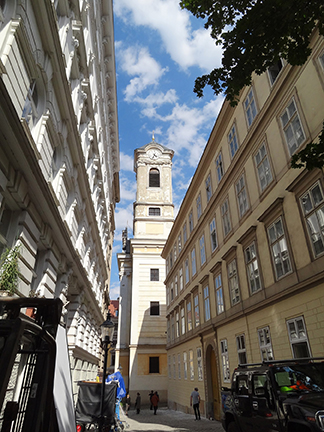
I spent this picture-perfect weather day getting my bearings, following a map and walking in the direction of the museums, including the Museum of Art and the Natural History Museum. The museums, theaters and government buildings were mostly built in the last decades of the 19th century, in a grandiose redevelopment plan that changed Vienna from a medieval, renaissance walled city, to a symbol of European power and culture. This occurred during the long reign of Emperor Franz Joseph, one of the iconic rulers in history, whose image is on numerous souvenir shop merchandise today as it was in 1914.
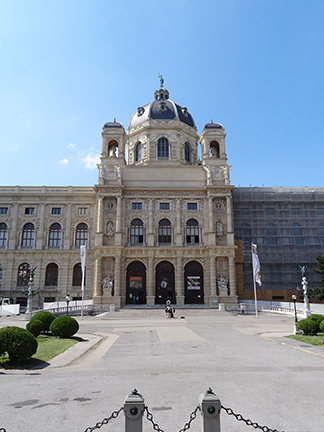
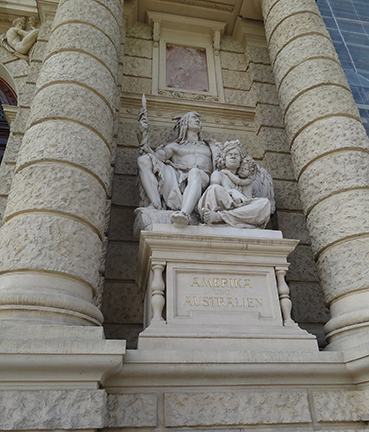
I met up with John Deak, a history professor at Notre Dame, who has been in Vienna since the end of May doing research on the Habsburgs and the Austro-Hungarian Empire. John’s been to Vienna numerous times and even spent a year at the university for his studies. He speaks Viennese German, pointing out a few distinctions from the language spoken by Germans. Needless to say, with all of his time here, he knows a LOT about Vienna's and Austria's history and makes an excellent tour guide. We enjoyed a nice dinner at a restaurant called Einstein's (named for Albert) which is across the street from the university. Then, we took an evening walk through downtown of historic structures, shopping districts (for those who have visited Kansas City, Mo., think of the Country Club Plaza, but on a much more ostentatious scale). Even with the modern stores and commercialism, the whole setting breathes history because there is so much around.
Tomorrow I have a lunch appointment with two officials at the Austrian National Library, which was one of the institutions that provided historical documents for the Museum’s “On the Brink” exhibition in Memory Hall and they will give me a tour of a news exhibition about Franz Joseph and WWI. I plan on visiting the crypt where the Habsburg monarchs are buried, except for Franz Joseph's successor, Karl, who lost his throne and burial place with his ancestors with Austria-Hungary's loss in WWI.
Vienna
Tuesday, June 24
My second day in Vienna – another perfect weather day for lots of walking, which I did, mostly on cobblestones in the city's old central section. Cobblestones seem to go with historical buildings. There were school and tourist groups everywhere – even a tour group on bicycles.
I visited with Dr. Hans Petschar, the director of the picture (visual) archive and graphics collection at the Austrian National Library, which is located in the Hofburg. Built as a palace for the Austrian emperors and refurbished by Franz Joseph around the turn of the century, it is a complex of the library and museums as well as government offices, including that of the Austrian president. It still retains an imperial presence with a museum that houses the "crown jewels" of the monarchy (see picture of main entrance to the right which faces the huge public space called Heldenplatz).
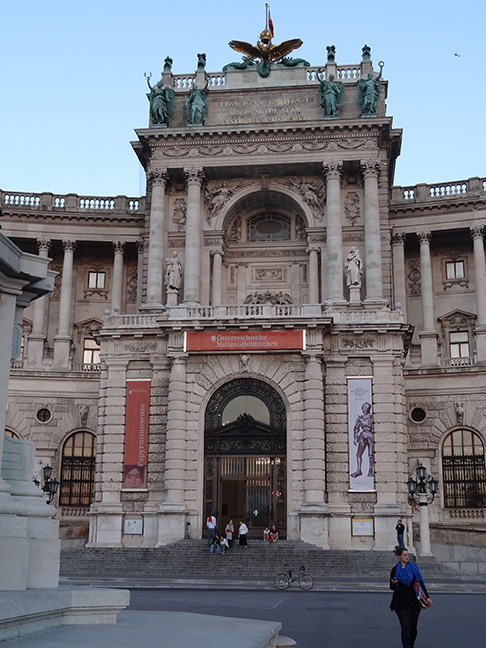
Dr. Petschar has been with the library for almost 30 years and will be coming to Kansas City in September for the German Studies Association conference to participate in a panel moderated by Professor John Deak. He will travel more than 10 hours by plane and he will talk for about 20 minutes. It will be his first time to Kansas City and, of course, the National World War I Museum, so I look forward to his presumably positive reaction (I told him it was worth the trip; I also suggested that he visit other sites while in the area).
Dr. Petschar gave me a tour of an exhibit he curated about WWI “An Meine Volker!” that uses broadsides, posters, postcards, letters, children's drawings and games to tell the narrative of the war years. It included a video of still images made from glass negatives of scenes from the Eastern and Italian Fronts: the Austro-Hungarian killing fields. Dr. Petschar told me that there aren't many photographs from the first months of the war, mostly illustrations and sketches by combat artists, so the photographic record does not start until 1915. He mentioned that about 1 million soldiers of the KuK (Imperial and Royal) army were casualties in 1914 alone, wiping out the officers and the professional core of the army. Displaced by advancing Russians, all of these casualties and civilians from the empire's Eastern frontiers migrated to Vienna, a city of 2 million, and its support systems for care and feeding quickly broke down.
The exhibit's narrative discusses the necessity to produce food for civilians in all parts of the empire, not only the army. People were instructed on how to deal with the food shortage, using cookbooks and other objects to address scarce resources for producing food, such as a poster asking people to collect “may bugs” to feed to chickens and hogs in place of regular feed. I recommend viewing our Museum’s online exhibition War Fare to get an understanding of this enormous logistical problem throughout the war.
The exhibit is in the Imperial Court library, a space constructed in the 1720-30s, with vaulted ceilings, painted with murals of historical and/or allegorical figures and both sides of the hall lined with soaring bookcases, filled with leather bound volumes of everything imaginable that have been collected over centuries. Immediately upon entering the space, the smell of musty paper/leather hit me, but what can one expect? Dr. Petschar said it is one of the largest libraries in Europe and is being digitized by Google – I can't begin to imagine the scale of this project.
We ate lunch at a place close to the library that serves traditional Viennese fare, which can cover a lot since there have been many culinary influences over the centuries. "Bohemian" is how Dr. Petschar described my meal – breaded pork cutlets with dumplings with gravy; for dessert, a chocolate sucher cake, cream on the side. We talked a bit about Austria's decision to go to war in 1914, mainly because its army commander wanted a war – if not with Serbia, with somebody. Then, once the decision was made and set in motion, the mechanism of mobilization kicked in. Austria wasn't prepared to fight a multi-front war. When it sent its forces south to Bosnia and Serbia, they had to shortly adjust and start moving East to face the Russians.
The present intervened during my appointment – President of Russia Vladimir Putin was in town, talking business with the Austrian president, so police and barricades were frequent in the area around the library.
A few images from the day:
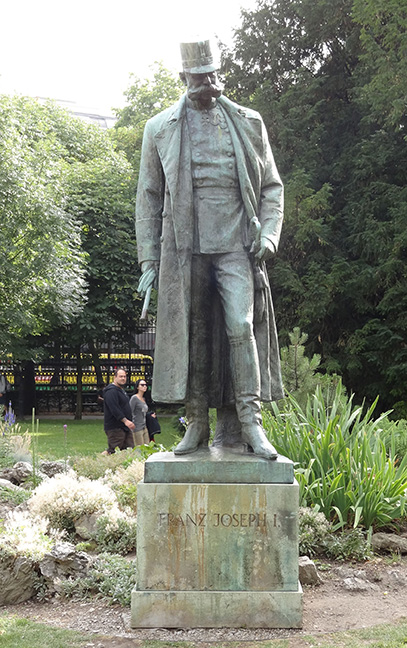
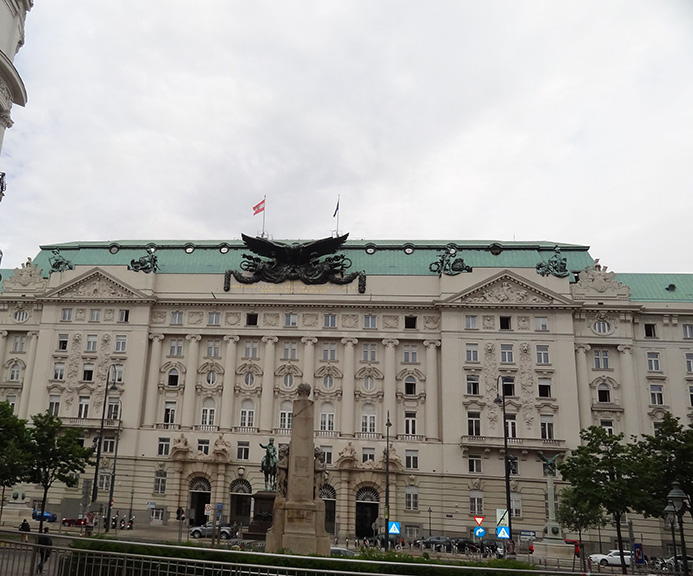
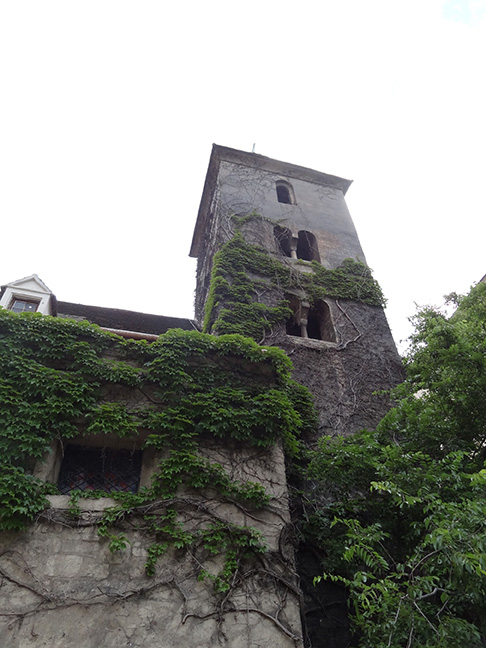
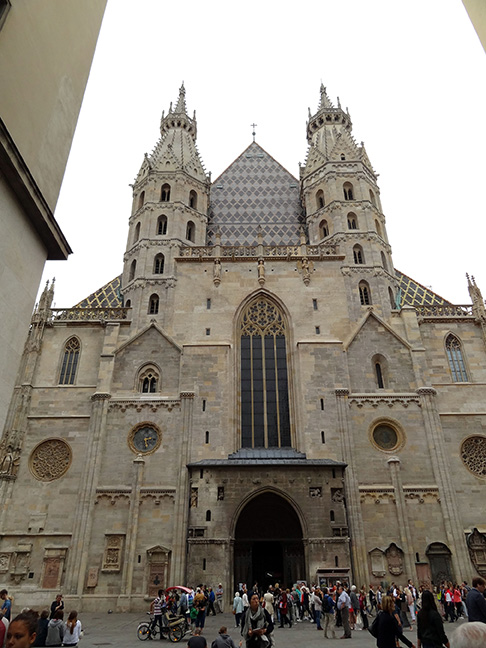
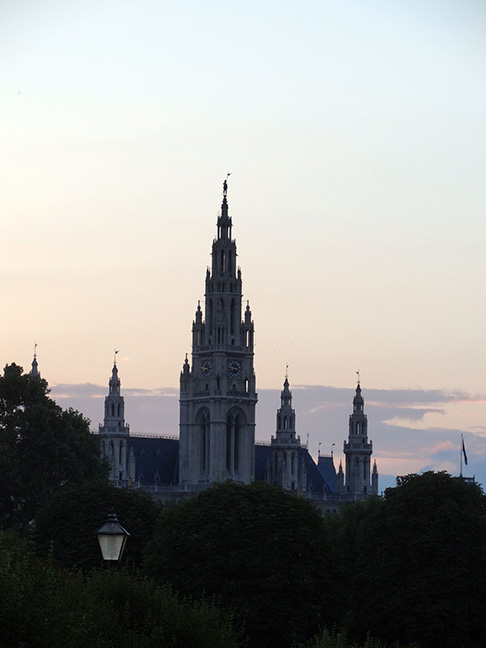
Tomorrow I plan on the Habsburg rulers’ burial place, the "crown jewels" exhibit in the Hofburg and a WWI art exhibit.
Vienna
Wednesday, June 25
Today was a more relaxed day – a nice contrasts to the first two days, which were a bit of a rush and tiring.
I visited an exhibit in the Leopold Museum about the Austrian experience in WWI through art and archival documents. I had seen an outdoor advertisement for what seemed to be a WWI art show – an impressionistic, slightly abstract drawing of a man's face in black, background in red, with a German title and dates 1914-1918. This was the cover of an exhibit catalog in an art bookstore, with a title in German I can't recall, but it translates to “Yet There Was Art!,” meaning that throughout the horrible experience of the war, the sane side of the human condition survived and creativity and imagination were used for non-violent purposes.
If the exhibit had been purely an “art” exhibit, I probably wouldn't have cared for it, but there were a number of archival documents and art in the form of posters about art shows – "kunststellungs" in various cities throughout the Empire that were about the Imperial and Royal (KuK) Army. There was even a M1917 KuK “stahlhlem” steel helmet that was pretty beat up, albeit with a post-war Austrian Republic insignia decal.
The first object displayed is symbolic of this history tour – the death certificate for Archduke Franz Ferdinand, death year 1914, date June 28, place Sarajevo. The exhibit included several media forms, using period footage projected on a wall in the first gallery and quotes in German from what I assume were artists discussing the war's effect on them. The exhibit included several somewhat naturalistic/somewhat abstract paintings of soldiers on battlefields or No Man's Land, using what looked like “potato masher” grenades as entrenching shovels.
One gallery focused on the artist Egon Schiele (whose self-portrait is used as the exhibit's iconic graphic), who served through most of the war at different locations in Austria (mostly in Vienna) learning about barbed wire and what is today the Czech Republic. One of his assignments was working in an office processing Russian prisoners. There were the usual painted portraits of soldiers, but also at least one gallery of female nudes and other superficially non-war related subject matter.
Most galleries were dark, but in contrast, one of the last galleries I visited was bright white and featured modern color photographs of what I understood to be various places in what was the Italian front of the war that presented the mountainous, snowy environment the KuK forces coped with.
After leaving the museum, I walked through the Burg Garten to see Franz Joseph's lonely statue and then walked up to the arts academy. This is the school that Adolph Hitler, a native Austrian, was rejected from before the war. He wanted to study art and live the artist's life – he did the latter living in poverty in Vienna, much to his distaste. After being unsuccessful in his dream to amount to something in his native land, when the war started, he joined the German Army because he did not want to serve in the “polyglot” KuK army.
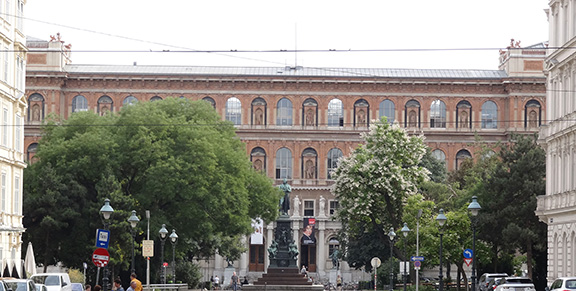
My next stop was at the Imperial Crypt, the place where “all the bodies are buried” as the final resting place for Habsburg rulers and their lineage, which adjoins a Capuchin church dating to the 1600s. In the church, there are several plaques on a wall at the back commemorating regiments in the KuK army for dates spanning the late 1800s to 1918. As expected, one descends to the crypt vault, and walks a winding aisle, lined with stand-alone caskets. The first few are small, plain and stacked in niches two high and these are infants and children of the imperial lineage. Immediately following those and dating to the 1600s or earlier, are singularly “baroque” caskets, their metal work ornate with skulls and veiled heads, large crucifixes and effigies of the inhabitants.
For more modern years, the caskets are much plainer. In a separate room lies Emperor Franz Joseph, between his wife, Elizabeth (who was killed by an anarchist assassin), and his son, Rudolph, who committed suicide (thus, leaving the succession for Franz Ferdinand). Visitors have left mementos such as flowers and cards wishing the family a peaceful rest around all three wreaths, one of which includes the Hungarian national colors. The wife and two sons of the last emperor, Karl, are in an adjacent room, also adorned with mementos. There is a bust of Karl, his remains resting elsewhere. Karl’s eldest son, Otto, died recently in 2011.
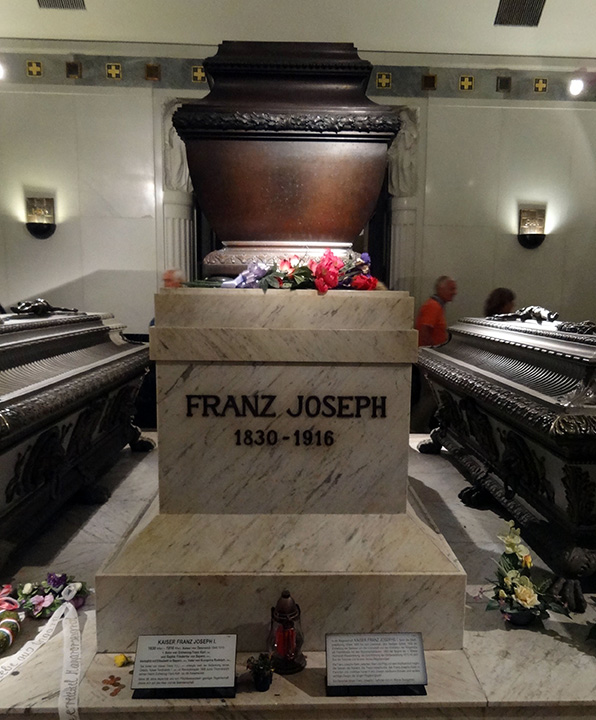
In the room before that where Franz Joseph lies, there is a plaque on the wall commemorating Franz Ferdinand and his wife Sophie, the first victims of the First World War (see left). They are buried at their “home” castle of Artstetten.
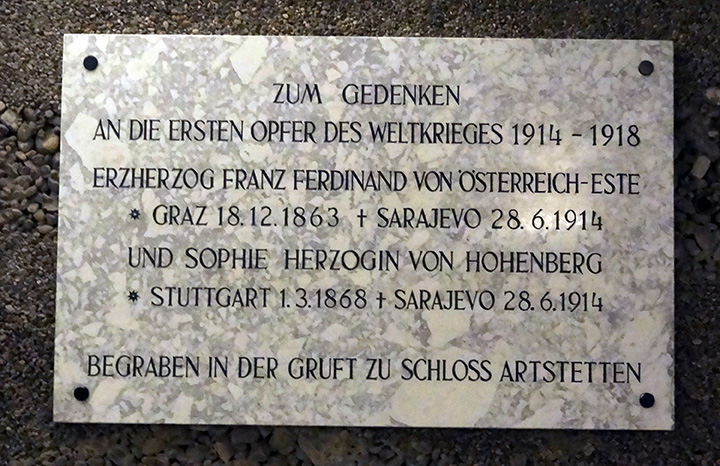
Tomorrow’s activities are still to be determined, but I’m thinking about a preliminary visit to the army history museum, whose new WWI exhibit doesn't open until June 28, which I will see when I return to Vienna. Then, I'm off to Sarajevo in the evening.
Travel Woes
Thursday, June 26
My first itinerary issue on the eyewitness tour 2014 occurred today. The flight from Vienna to Sarajevo was overbooked, so I am spending an extra night in Vienna, courtesy of Austrian Airlines. I will say that they’re providing nicer accommodations than what I've had the last three nights with a 250 Euro prepaid card, transportation to and from the hotel and 12 Euros for a meal at the airport.
My plane reservation from Vienna to Sarajevo was made in January and I had a confirmation number, but I didn't confirm a seat on-line so I was bumped to standby. ALL BOW TO THE INTERNET and MEA CULPA! Your intrepid blogger blogs on! Eyewitnessing history is not for the faint of heart!
I took of few pics of posters of the WWI art exhibit and rock concert promotions, but my camera is in my bag at Sarajevo as I type. Eric Clapton is playing here tonight – I wish I could have gone! Maybe I’ll see him in Kansas City sometime.
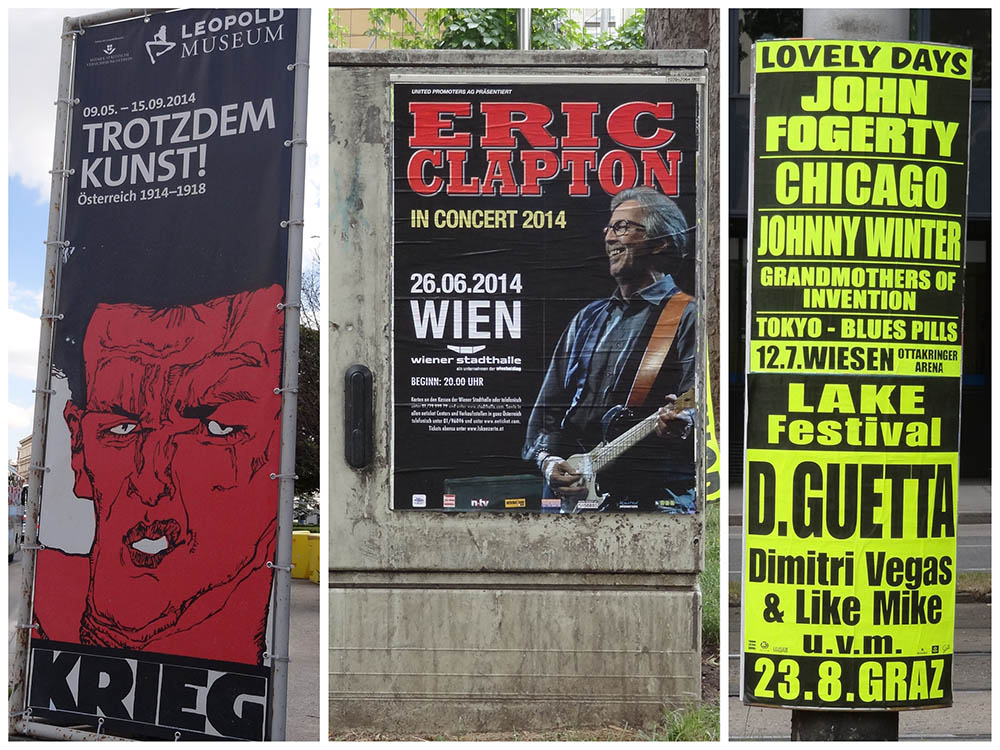
Ivan Breszak Brkan is a fellow traveler who also had to be re-booked for a flight to Zagreb, Croatia. He appears to be in his 20s, speaks very good English without a discernible accent and is the founder and editor-in-chief of Netokracija Central, Eastern Europe's Best Startup and Web Business Source. He is also the founder and CEO of MeMe Media, Awesome and Effective Web content for Brands that Deserve It. I gave him my card and he says he knows some people in Sarajevo.
Last night on what appears to be Vienna's public TV station,there was a story about the "An Meiner Volker" WWI exhibit at the Austrian National Library that I saw with Dr. Hans Petschar on Tuesday. Military historians were interviewed and an individual dressed as Franz Joseph.
Tomorrow I get to Sarajevo (hopefully!) a little after a delay, but I’m ready for the 100th anniversary.
Sarajevo Arrival
Friday, June 27
I arrived in Sarajevo today – 24 hours after originally scheduled – but still with plenty of time to walk around the old city.
On my way in from the airport, I noticed a lot of damage from the civil war in the 1990s, pockmarked high rise apartment buildings that had been built in the 1970s/80s, I presume in anticipation of the 1984 Winter Olympics. My driver said they are well built and much of the damage has been repaired, but the scars remain. I didn't catch his name, but he spoke decent English and we talked during the entire ride. He was probably in his 40s, grew up in Sarajevo, lived through the civil war and was a contractor in Iraq and Afghanistan – a true survivor.
I used a literary reference as the opening to my first blog posting, metaphorically referring to Sarajevo as a “City of Darkness and Backwardness,” the place used by the Franz Ferdinand assassination conspirators to hide in waiting. After I wrote that, it seemed like a slight, but the only thing I knew about Sarajevo was that it was the place of an event that caused an enormously destructive war.
As I drove along the Miljecka river into the old city by cab on one of the main thoroughfares like Franz Ferdinand and Sophie did a day short of 100 years ago, my overall impression of the city was how crowded everything is and how grimy and run-down most of the buildings looked – some along the river had large amounts of graffiti. For the most part, they looked architecturally like the buildings in Vienna, what I would call 19th century European: several stories tall, made of plaster, brick, concrete and with large amounts of window/doorway ornamentation. However, some possess a clearly Turkish/Islamic influence with pointed arched windows and geometric lattice work.
There is also a street car/tram line that runs down the middle of a grassy median (looking like the streetcar system in New Orleans). The city seems like Vienna's poor relation, but it is an entirely unfair comparison. Sarajevo has its share of tall glass, modern buildings and commercialism. Mainly, it seems as if it’s still recovering from so much devastation in recent history.
I was dropped off at the hotel where 2012 National World War I Museum Teacher Fellow Lisa Adeli, her husband Aman and their friend Fati are staying. We walked around and ate dinner in a tiny place along a main street filled with restaurants and shops. The streets are narrow, windy and paved with field stones that are worn and uneven. We walked along the river, catching a cool breeze off the water, which was flowing quickly due to recent rainfall.
The most intriguing thing so far about this city is the Turkish legacy from an occupation of 500 years. Mosques have their minarets, lit up at night, and fly the green with white crescent moon and star Islamic flag (like a Catholic church displaying a Papal flag). I saw many women wearing head scarves as today is a Friday, the Muslim day of worship, and Ramadan begins soon. The old market is also a distinctly Turkish style building. This will probably be my only time in this country and, as such, the only experience I will have in what could be described as a Muslim country. That said, there are plenty of restaurants serving alcohol and young people wearing very Western, secular attire.
Tomorrow is "the day" with lots to visit and photos to take.
Sarajevo & The Centennial
Saturday, June 28
At 9 a.m. today only a few history centenary observers were at the place where Gavrilo Princip fired the two most fatal shots in history.
At 11 a.m., the approximate time the assassination took place a century ago, the narrow street in front of what was Moritz Schiller's store in 1914 was packed side-to-side around a Gräf & Stift car with stand- ins of Archduke Franz Ferdinand and Sophie. We witnessed conversations in several languages spoken on top of each other, international film crews, many cameras taking pictures and what appeared to be a small Serbian Bosnian rally. However, we saw no violence on this June 28. I Leaned up against the wall near a plaque about the assassination where two wreaths were laid for the unfortunate couple.
Schiller's store is now an assassination museum and although only one room has a well done exhibit, there is a good mixture of archival and 3D objects to interpret what Sarajevo was like under Hapsburg rule and the assassination conspirators.
I’ll let the pictures speak for themselves...
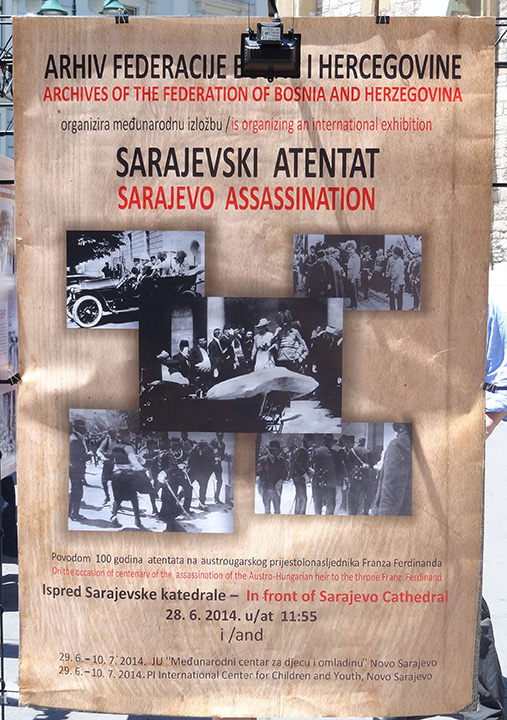
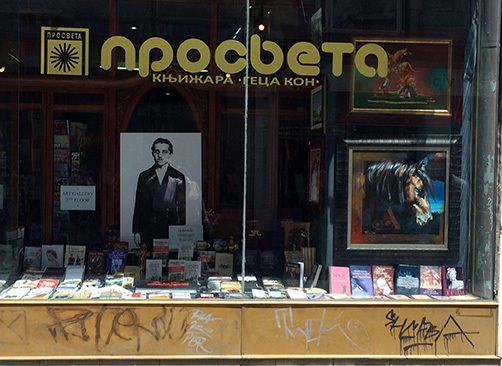
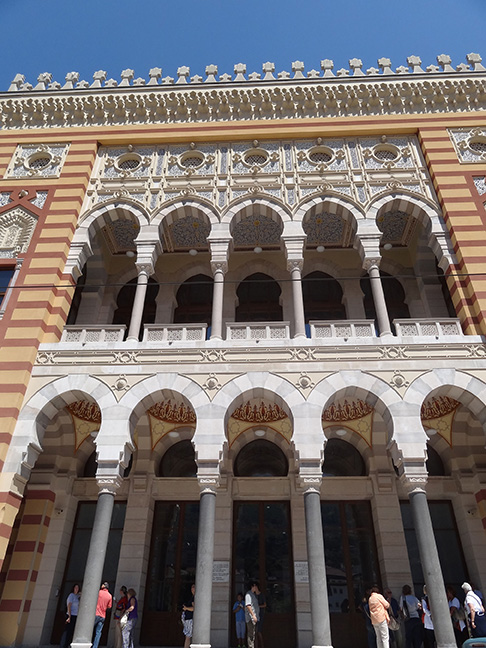
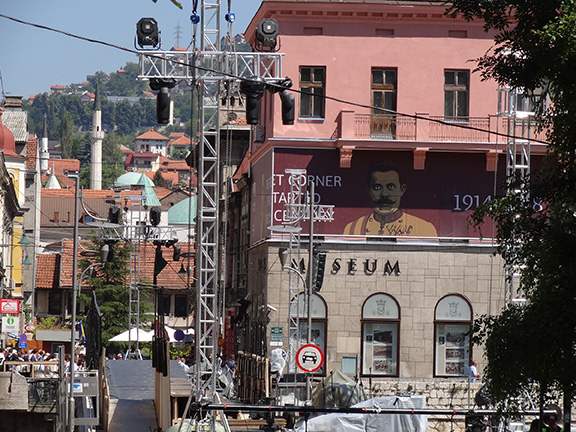
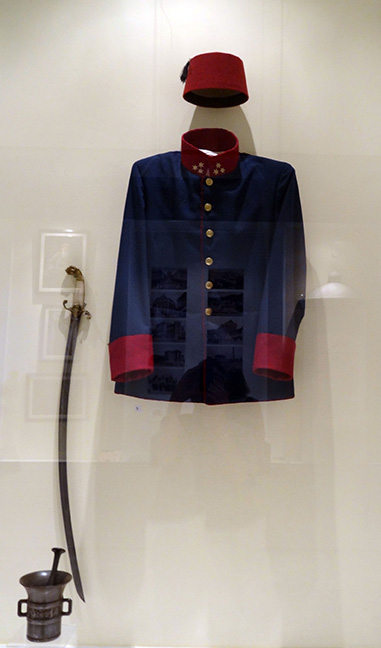
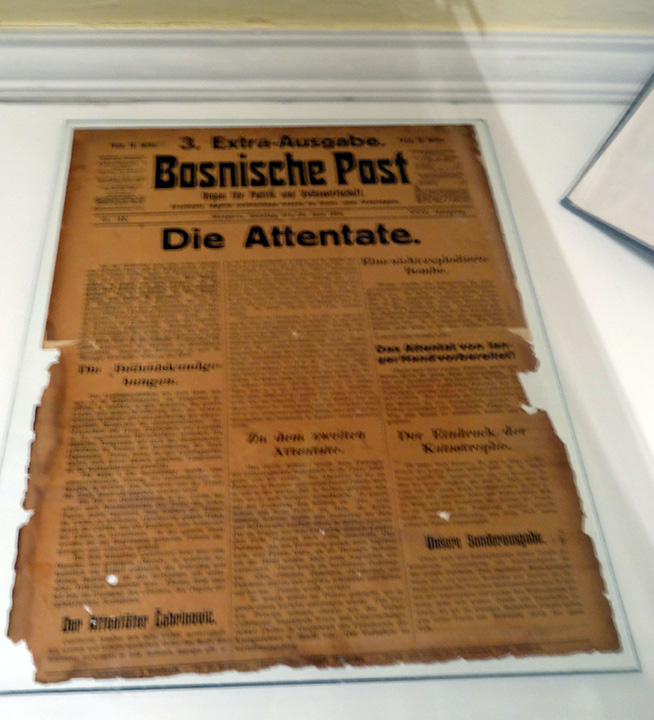
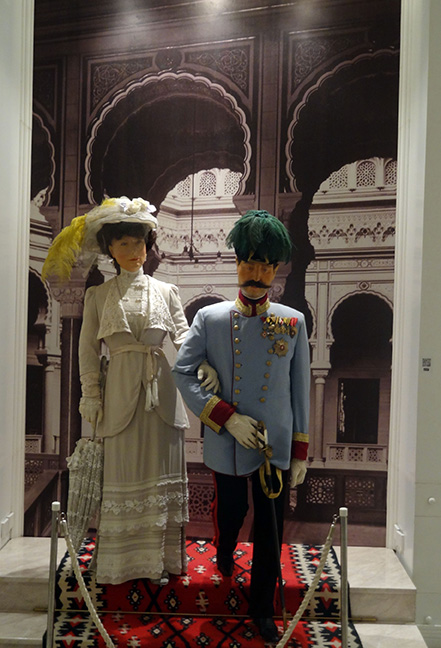
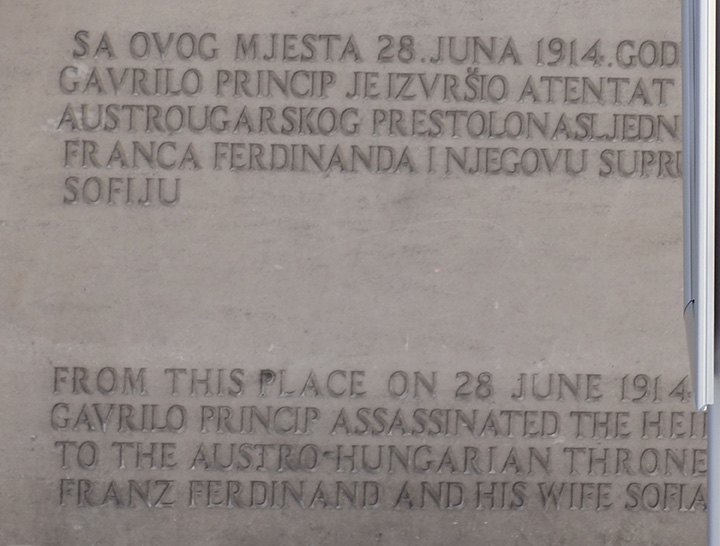
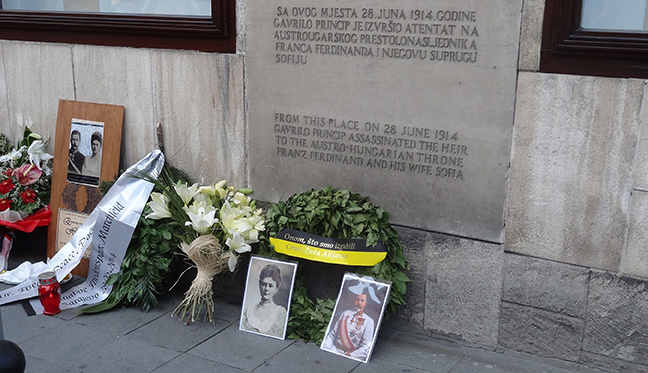
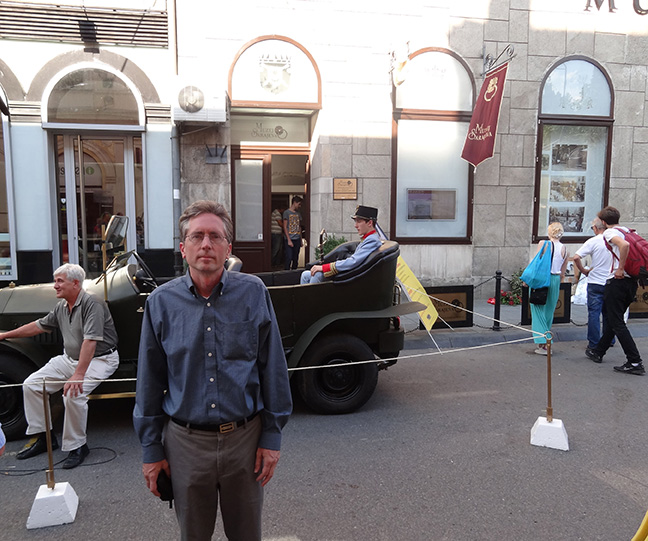
Sarajevo
Monday, June 30
On Saturday night (June 28), there was a commemorative concert given by the Vienna Philharmonic Orchestra at what was the city hall building in 1914. A number of heads of state and political dignitaries were in the audience, including Chancellor of Germany Angela Merkel, and, because of that, there was also plenty of police security. We watched some of the VIPs arrive across the Miljacka River opposite the venue. There was a large screen set up in a parking lot with reserved seating where we could watch the concert and a stage at the back with TV cameras. Apparently, the concert and proceedings were being broadcast live throughout Europe.
About 10 protestors positioned themselves along the river walk opposite the City Hall and were being interviewed by media. They held handmade signs in English and Bosnian about how Gavrilo Princip had acted against imperialism and for nationalism and were equating the Austrian imperialism of his day with European Union “imperialism.” One sign read, “We spent 2 million euros for this” in reference to the concert and preparations. Another sign had the letters “MMF” which may refer to the International Monetary Fund or the World Bank. Some of the protestors even wore Princip masks. Later at least two of these masked protestors moved to the assassination place, holding one of the same signs.
Today marked my last full day in Sarajevo. I walked from my hotel into the old city and to the Latin bridge, which was closed on the June 28 because of the commemoration. I stopped in front of the assassination museum that has a large red banner wrapped around it with Princip's and Franz Ferdinand's images.
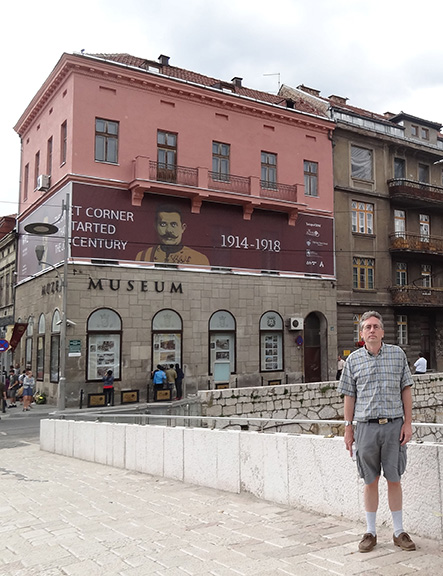
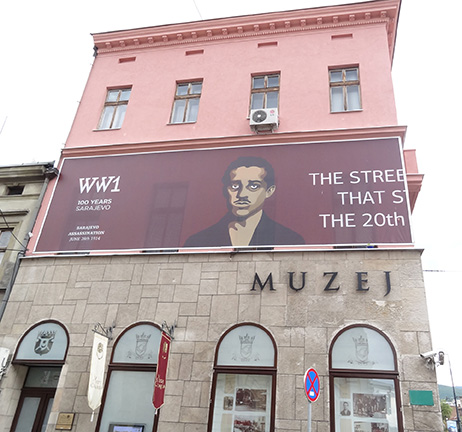
On Saturday, I came across a “Franz Ferdinand” hostel and took a picture of its sign, but didn't have a chance to visit. On Sunday, while having dinner and watching the news channel, there was a story about this establishment, showing the rooms decorated with images of WWI and the imperial couple. This reminded me of a partnership between the National World War I Museum and a Kansas City business, the 816 Hotel in Westport, which has Kansas City-themed rooms, one being the Museum with a an entire wall covered with a mural of the Pantheon de la Guerre.
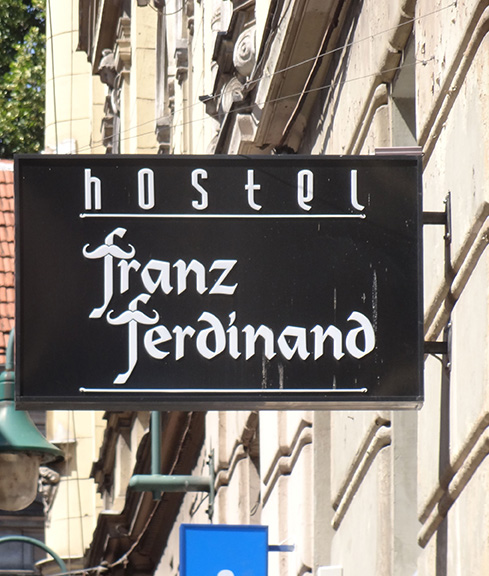
The Franz Ferdinand hostel is in a building probably 100-years old and apparently has been a hotel or hostel for nearly that entire time. However, the desk clerk said it had been WWI-themed for only eight months. There are about 10 bedrooms and two dining areas, each with a theme. The dining areas had political cartoonish maps, which could have been illustrations from magazines, covering a wall. The rooms had archival photos and maps, some covering the walls and ceiling. This was the case for the Franz Ferdinand and Sophie Chotek room and the Gallipoli room. The Sophie Chotek room included an image likely from around the time when she first married the Franz Ferdinand as she looked like a woman in a wall painting in a Pompeii house.
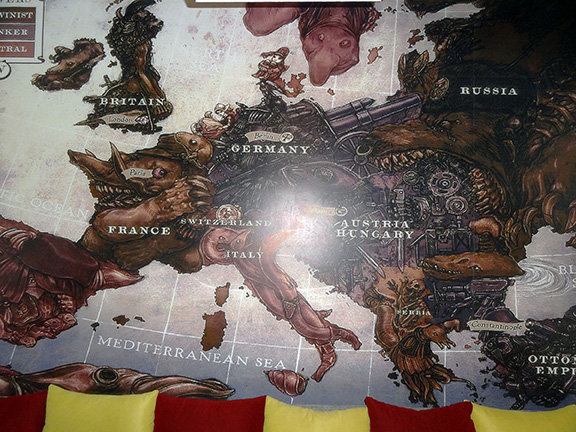
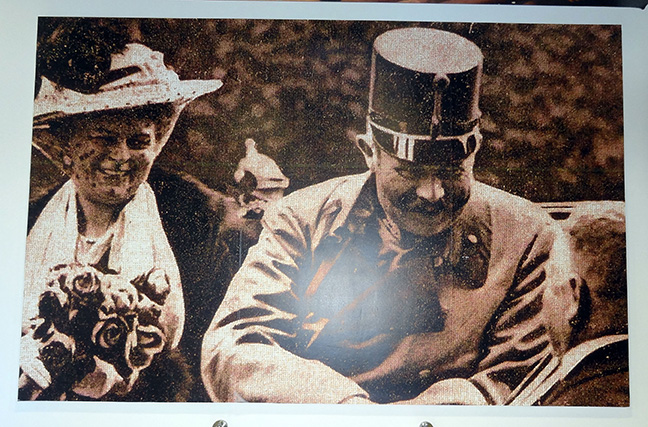
The Gallipoli room showcased a map of Gallipoli showing the landing beaches on the ceiling, excellent images of Turkish soldiers and a great photo of Australians posing while wearing their iconic slough hats. The Lusitania room had newspaper or magazine illustrations of the ship sinking on the walls. The Princip room only had his “mug shot” image on the ceiling. Along the upstairs hallway on one side were floor to ceiling images of German soldiers in 1914 field uniforms.
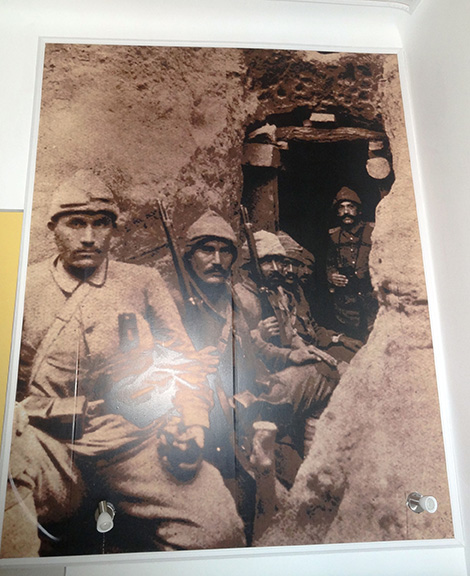
There were rooms for Verdun letters as well as the Red Baron, but we did not see them because they were occupied. In the lobby was an image of Franz Ferdinand and Sophie in the fatal car with a description in English about the assassination. On the floor downstairs was a timeline in English about the events of late June and a timed sequence of events, like news reporting, for June 28 itself. Upstairs was another timeline for the war year-by-year.
Tomorrow: back to Vienna in anticipation of my visit to the Army History Museum on Wednesday.
Sarajevo & Return to Vienna
Tuesday, July 1
I spent my last day in Sarajevo with a brief visit to the city museum to see a World War I exhibition. There weren’t a significant amount of actual objects, but instead, mostly archival material, such as broadsides and newspapers. There were a few rifles and a Maxim machine gun, a few paintings/drawings, a medal grouping for a high ranking Muslim Bosnian officer. Overall, the exhibition featured documents and photos used as graphics for the most part. There were also two video monitors with still images, one in somewhat of a theater type of arrangement showing battles and marches and the other showing scenes of Sarajevo in 1914.
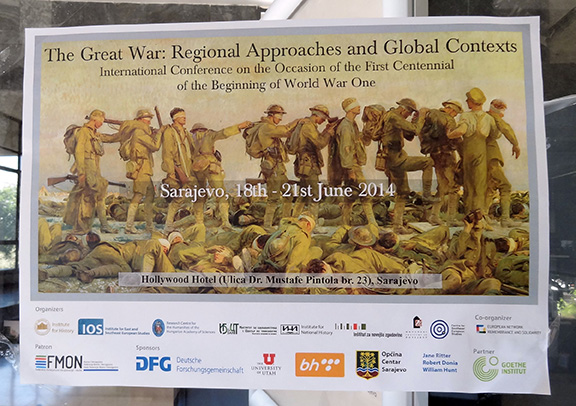
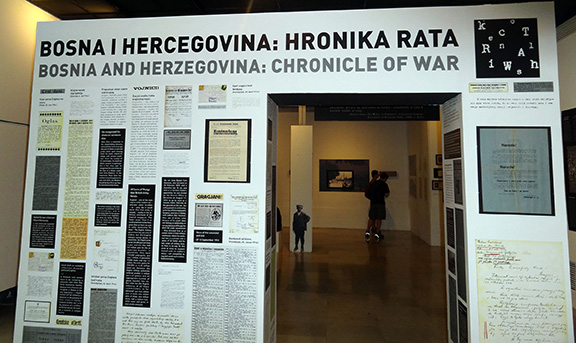
The museum’s narrative focuses on the Balkans and Eastern fronts, but also references the Italian and Western front and is told from the viewpoint of the common soldier or civilian. The narrative also includes letters from Bosnian-Herzegovinans to officials asking to be exempted from military service because of age and women being asked to help the war effort by reusing fabric for clothing. The exhibit also included an mage of an inscribed biscuit by an AnZAC soldier at Gallipoli and a proclamation for Franz Joseph's 66th year on the throne (toward the bottom you see "Zivio" three times, which means "hurrah").Perhaps the most important document was a day-to-day schedule for Archduke Franz Ferdinand's visit to Bosnia and Sarajevo.
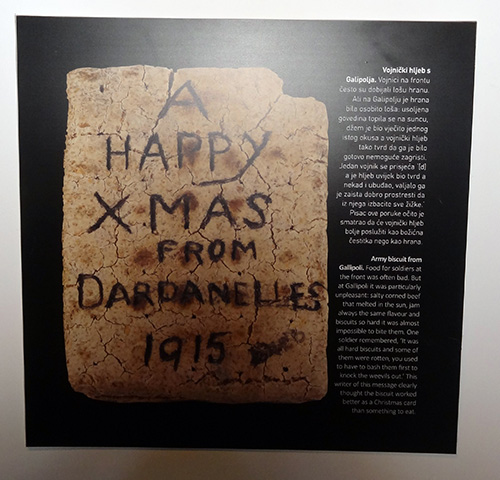
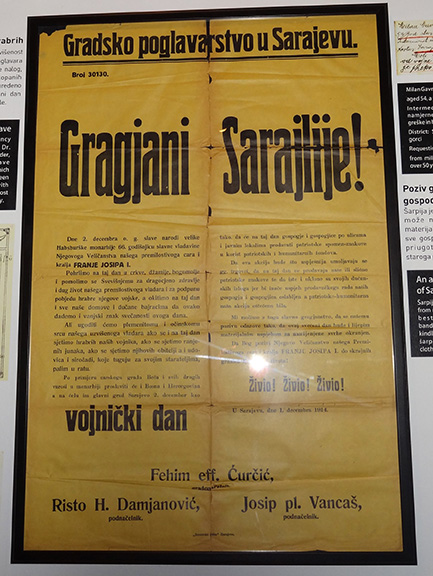
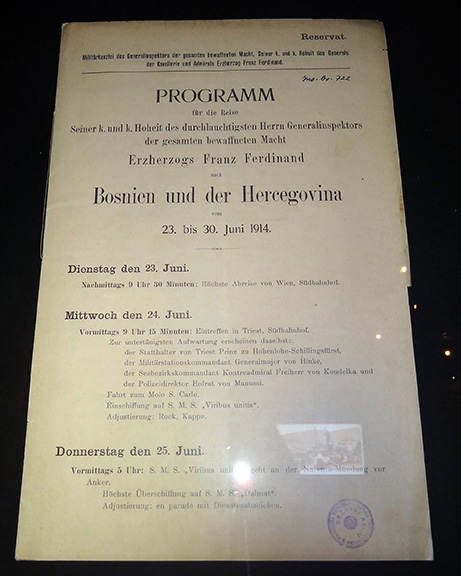
After my museum visit, I returned to Vienna this afternoon. I contacted the Army History Museum for my visit tomorrow and found out that someone in their press office will meet me at the front door at opening time.
"The Car"
Wednesday, July 2
Today was my last day in Vienna – I fly back to the U.S. tomorrow. Though I’ll be back in the U.S. soon, I’m still processing things.
Today, I visited the Heersgeschitelichesmuseum HGM (the army history museum) to see its World War I exhibition that opened on June 28. The museum is in a large brick building inside a fortress structure and it’s appropriate because it was the Vienna arsenal. Like so many public buildings in Vienna, it was built in the late 19th century during Franz Joseph's reign. Joseph led the empire for 68 years, witnessing a significant amount of history, peace and conflict.
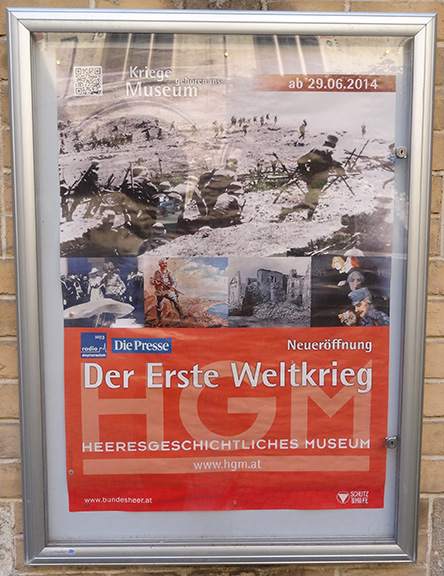
The museum interprets the entire sweep of Austrian military and naval history, from the middle ages to the 20th century. The primary reason for me visiting is that the museum houses the car that Franz Ferdinand and Sophie Chotek were riding in when they were shot in Sarajevo on June 28, 1914. The car looks just like the photos I've seen (as it should), but to see it in person is riveting knowing who rode in the vehicle and the magnitude of the event surrounding it. The car itself is a character in the assassination drama. You can see two bullet holes and, from what I know of where the couple was wounded, I think Gavrilo Princip may have fired more than twice. I read an online article about the car being cursed and coincidences surrounding its history, one being its license plate reads “AIII 118,” which could refer to 11/11/18 – the last day of World War I.
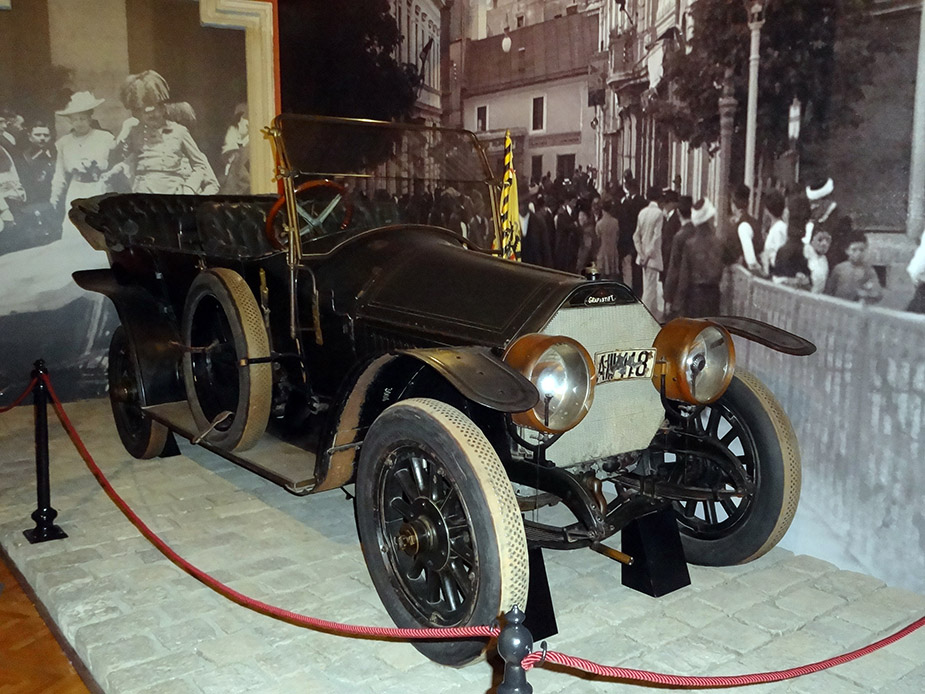
Across from the vehicle is another June 28 touchstone, the bloodstained, sky-blue tunic of an Austro-Hungarian cavalry general that Franz Ferdinand was wearing. The tunic has long cuts in the left breast where it apparently was cut by someone trying to save his life by massaging his heart. Franz Ferdinand was hit in the neck and the inside collar is completely stained. Nearby is his white undershirt that is stained with the cuffs folded across the front looking out of place. There are mementoes of Sophie's dying moment – flower petals and lace that looks blood stained. Between the couple's personal objects and the car are three pistols used by the conspirators and an unexploded bomb.
There are portraits of Franz Ferdinand and Sophie on the wall as well as a video of the event and immediate aftermath, showing non-Serb Bosnians rioting against Serbs and destroying property because of Princip's actions. This made me think of a connection of hate and violence between these groups that festered from 1914 to the civil war in the 1990s in which thousands were killed and Sarajevo destroyed.
These objects are in a room by themselves following a gallery with an exhibition about the pre-war Austro-Hungarian army with many resplendent uniforms and 19th century sensibilities about war. It’s followed by the new World War I exhibition with camouflaged field uniforms, steel helmets, trench weapons, aerial warfare, multiple campaign fronts and multiple weapons systems. The most stunning is the 35cm Skoda siege howitzer, a massive piece of firepower that fired huge projectiles that had to be moved on a cart. The gun moved into position by electric motors and took a whole day to set up for firing. When used in the Italian front mountains, it took days of setup.
Overall, it is an excellent exhibition that interprets the diversity of the war, the nationalities/ethnic groups involved covering Eastern, Southern Europe (from Russia to Italy to the Balkans), the Western Front where they put the Skoda howitzer to good use and even to Turkey to China. I was surprised that Austro-Hungarian forces were in Turkey and Palestine and supporting the German colony Tsingtao with a naval force.
Tomorrow, I’ll some final thoughts and comments about this incredible trip.
Final Thoughts
Friday, July 4
I thought I would share some final comments from my Eyewitness to History tour.
Dr. Hans Petschar, Director of the Picture Archives and Graphics Collection at the Austrian National Library, shared some insight about how Austrian views World War I, how the country is observing the Centennial and how the press is covering the event. He said that the official commemoration of the war occurred on June 18 at the National Library, which was also the Centennial of the death of Bertha von Suttner, who was an Austrian pacifist. The Austrian President, Dr. Heinz Fischer, in a speech one June 18 referred to Suttner as a modern "Cassandra" (a Trojan woman in the "Iliad" who warned of the fall of Troy but was not listened to), who in vain warned about the catastrophic consequences of war. The President offered examples of political crises since WWI, including the current Ukrainian crisis, that at have led to war or nearly so. Dr. Petschar said that maintaining dialogue in a time of crisis seems to be the personal position of the Austrian President and also the official Austrian position as a lesson learned from World War I.
When the taxi was close to the hotel in Vienna on my first day of the tour, June 23, I noticed part of the street blocked off, vans parked along the side and cameras/lights set up on a side street, presumably for filming. As I was walking around the hotel area that afternoon I saw more of the film set up, which included a World War I period military vehicle with a German SS license plate and persons dressed as German SS soldiers, with helmets, rifles and wearing swastika armbands. I watched for a while as close as I could and took a few pictures. A crew member told me to move back just before the action started. In Austria, it is illegal to display the swastika except for in a movie or a historical exhibit. The movie set with swastika-wearing soldiers was ironic as Adolf Hitler, the person who took over the fledgling Nazi party in the early 1920s, became ruler of Germany and orchestrated the annexation of Austria, was actually an Austrian native.
The Centennial of the first declaration of war as part of World War I is on July 28, but in the shadow of this monumentally destructive, world-changing event is the 75th anniversary of a second, even more destructive world war on Sept. 1.
